I didn’t know what to expect Cappadocia. All I knew before visiting this famous region of Turkey (pronounced cappa-doe-kiya, as I subsequently discovered) was that there were caves that you could stay in, the hot air ballooning was pretty good and there were fairy chimneys made out of rock .
I arrived after an hour’s budget flight from Istanbul to a spectacularly unusual and beautiful landscape of vast green plains sprinkled with spring flowers, snow-sprinkled mountains, hilltop villages of castles and caves that look like unfinished clay sculptures, curvy cliffs, spindly volcanic rocks jutting out from the ground like sand-coloured ice lollies, valleys covered in vineyards and ancient rock-hewn monasteries and churches and massive underground cities. I had planned to stay in Cappadocia for four days, but wished I’d stayed for weeks.
These are my highlights of this other-worldy, fascinating place.
1. Hot air ballooning
If this isn’t on your bucket list, it should be. You lift off at dawn surrounded by about 100 other hot air balloons filled with people mesmerised by the sight of golden sunlight spreading across the magical Cappadocian landscape. (Read more about how awesome hot air ballooning in Cappadocia is here.)
2. Epic history
Cappadocia’s remarkable history spans millennia – it was first settled by the Hittites in 1800BC, was part of the Persian Empire in the 6th century BC, was mentioned by the Ancient Greek historian Herodotus and written about in the Old Testament, ruled over by feudal lords and Alexander the Great, was home to early Christians (the religion flourished here between the 4th and 11th centuries) and formed part of the Roman, Byzantine and Ottoman Empires. Epic is an understatement.
3. Staying in boutique cave hotels
Cappadocia is cave paradise. Along with all the abandoned caves (local people lived in them until the 1950s, when erosion meant that they were unstable and unsafe to live in), cave churches and cave monasteries, there are many troglodyte spaces that have been converted into backpackers and boutique hotels, the latter offering the ultimate in hobbit luxury. Cosy rooms, massive beds, flat-screen tvs and free wifi are pretty much a given at any boutique cave hotel. I loved the beautiful old antiques and traditional kilms with incredible hilltop views at Taskonaklar in Uchisar, and the funky modern furniture and a tranquil setting in one of Cappaodcia’s quietest villages at Hezen.
4. Hiking the Ihlara Valley
While I also loved hiking in the Zelve Valley, with its many cave dwellings to explore, and Pigeon Valley with its abandoned dovecotes, my favourite hiking spot was the green and lush Ihlara Valley, sandwiched inside a steep gorge. Here you walk alongside a clear stream surrounded by trees and red poppies to a soundtrack of tweeting birds and croaking frogs. Along the way are churches cut into the gorge and a delightful restaurant that only serves gozleme (rustic savoury pancake filled with cheese, potato and spinach) from wooden cabins perched on stilts in the stream.
5. Frescoes
Cappadocia’s cave churches aren’t just interesting because they’re in caves – they also have beautiful frescoes depicting biblical scenes. The best preserved ones are in the churches of the Goreme Open Air Museum and are between 800 and a thousand years old. They’re delicately painted (using the same sandstone and red-ochre colours of the rocks of Cappadocia), with each figure given a personality and details like a shiny silver fish on the table at the Last Supper given an astounding amount of attention.
6. Underground cities
A millenium ago, Christian inhabitants of Cappadocia faced persecution by Romans and the recurrent onslaught of marauding armies sweeping across the central Asian plains. Their solution was to make like moles and go underground, building cleverly designed vast underground warren-like cities (where they would live for months at a time) with churches, stables, school rooms, air ventilation shafts, homes and boulders for sealing off entrances from the invaders. Excavation work has only been done on small parts of only some cities, so we don’t even know the full scope of some of the cities’ sizes. I visited Kaymakli, one of the biggest underground cities, and had to fight back waves of overwhelming claustrophobic panic when squeezing through the tiny passageways, but still found myself marvelling at the ingenuity of the structure (while feeling grateful that I just have to lock a security gate to protect against invaders and not have to live like an ant for half the year).
7. Sunsets
That photographer-friendly soft light hour before dusk turns Cappadocia’s caves and rocks a rich gold and intensifies the shadows of hundreds of cave openings so that it looks like there are eyes and mouths of silent ghosts staring out at you.
8. Village life
Having our own car allowed us to get off the beaten track a bit in Cappadocia (which means escaping shop and restaurant filled Goreme and the tour buses on their set itineraries to see the main sights) and visit villages that are entirely untouched by tourism, where chickens ran in the street, old men walked arm-in-arm in a seemingly eternal uniform of cardigan waistcoat and flat cap and the only other vehicles around are tractors.
9. Swiss-cheese castles
Not like any citadels or chateaus I’ve ever seen before, Cappadocian castles, which are carved out of natural rock, look like a cross between Swiss cheese, something out of a Salvador Dali painting and a sculpture made by an eight year old. There are two castles in Cappadocia, in the villages of Uchisar and Ortahisar. Uchisar castle has the best views around (other than those from a hot air balloon basket), and the smaller Ortahisar castle (with less impressive views) has just been reopened after restoration work.
10. Gelato
As much as I adored trying Turkish ice cream (the thick and chewy dondurma), my best ice cream in Turkey was Italian-style gelato – almond and honey flavour, sprinkled with pistachios – from a cafe in Urgup called Merkez Pastanesi after a hot, sweaty hike in Zelve Valley.
Tip: Villages and sights are spread pretty far apart in Cappadocia, and though there is public transport it will be a mission to get anywhere. The other option is to take guided tours, but that means that you’re stuck on a big coach in a tour group. If that’s not your thing, then hire a car. It’s easy to drive around Cappadocia – everything’s well sign posted and the roads are fairly empty.
Google+
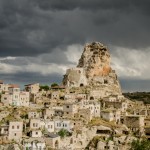
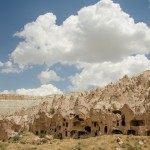

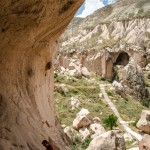


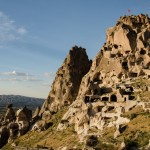
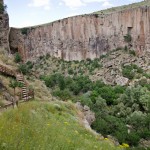
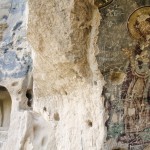

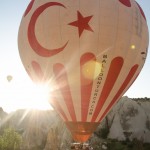
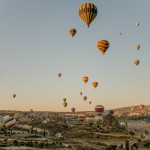
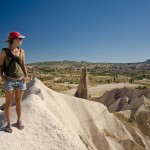
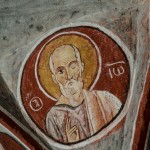
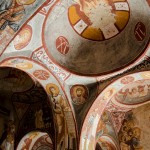
The photos are just out of this world. I really look forward to visiting this place one of these fine days – i never knew Turkey was this beautiful. Now i have added a new badge of fame to Turkey besides great fine men’s suits – spectacular scenic beauty!